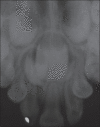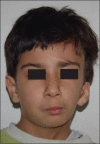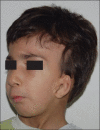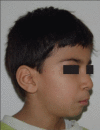Solitary median maxillary central incisor in association with hemifacial microsomia: A rare case report and review of literature
- PMID: 22346174
- PMCID: PMC3276874
- DOI: 10.4103/0976-237X.91810
Solitary median maxillary central incisor in association with hemifacial microsomia: A rare case report and review of literature
Abstract
Solitary median maxillary central incisor (SMMCI) is a rare dental anomaly. It is estimated to occur in 1:50,000 live births. The SMMCI tooth differs from the normal central incisor in that the crown form is symmetric and it develops and erupts precisely in the midline of the maxillary dental arch in both primary and permanent dentitions. Presence of SMMCI with hemifacial microsomia (HFM) is a very rare clinical condition. We report a case of HFM in a male of Indian origin who presented with SMMCI in both primary and permanent dentitions. The association of HFM with SMMCI may be due to defective development of neural crest cells and/or lack of space in maxilla.
Keywords: Hemifacial microsomia; anodontia; solitary median maxillary central incisor.
Conflict of interest statement
Figures








Similar articles
-
Clinical Evaluation of Solitary Median Maxillary Central Incisor Syndrome.Case Rep Dent. 2019 Sep 12;2019:2637825. doi: 10.1155/2019/2637825. eCollection 2019. Case Rep Dent. 2019. PMID: 31612083 Free PMC article.
-
Solitary median maxillary central incisor (SMMCI) syndrome.Orphanet J Rare Dis. 2006 Apr 9;1:12. doi: 10.1186/1750-1172-1-12. Orphanet J Rare Dis. 2006. PMID: 16722608 Free PMC article. Review.
-
[Solitary median maxillary central incisor syndrome:a case of report].Shanghai Kou Qiang Yi Xue. 2014 Apr;23(2):253-6. Shanghai Kou Qiang Yi Xue. 2014. PMID: 24935855 Chinese.
-
Solitary median maxillary central incisor syndrome associated with unique cleft palate: a rare case report.Gen Dent. 2014 Mar-Apr;62(2):e16-9. Gen Dent. 2014. PMID: 24598504
-
The solitary median maxillary central incisor (SMMCI) syndrome: Associations, prenatal diagnosis, and outcomes.Prenat Diagn. 2019 May;39(6):415-419. doi: 10.1002/pd.5451. Epub 2019 Apr 26. Prenat Diagn. 2019. PMID: 30900264 Review.
Cited by
-
Clinical Evaluation of Solitary Median Maxillary Central Incisor Syndrome.Case Rep Dent. 2019 Sep 12;2019:2637825. doi: 10.1155/2019/2637825. eCollection 2019. Case Rep Dent. 2019. PMID: 31612083 Free PMC article.
-
Solitary median maxillary central incisor in association with taurodontism and oligodontia: A case report.Clin Case Rep. 2023 Jun 23;11(6):e7603. doi: 10.1002/ccr3.7603. eCollection 2023 Jun. Clin Case Rep. 2023. PMID: 37361650 Free PMC article.
-
Solitary median maxillary central incisor syndrome (SMMCI) with congenital nasal puriform aperture stenosis: literature review and case report with comprehensive dental treatment and 14 years follow-up.Eur Arch Paediatr Dent. 2013 Dec;14(6):417-23. doi: 10.1007/s40368-013-0044-5. Epub 2013 Jun 18. Eur Arch Paediatr Dent. 2013. PMID: 23775592 Review.
References
-
- Garavelli L, Zanacca C, Caselli G, Banchini G, Dubourg C, David V, et al. Solitary median maxillary central incisor syndrome: clinical case with a novel mutation of sonic hedgehog. Am J Med Genet A. 2004;127:93–5. - PubMed
-
- Scott DC. Absence of upper central incisor. Br Dent J. 1958;104:247–8.
-
- Hall RK, Bankier A, Aldred MJ, Kan K, Lucas JO, Perks AG. Solitary median maxillary central incisor, short stature, choanal atresia/midnasal stenosis (SMMCI) syndrome. Oral Surg Oral Med Oral Pathol Oral Radiol Endod. 1997;84:651–62. - PubMed
-
- Rappaport EB, Ulstrom R, Gorlin RJ. Monosuperocentroinci-sivodontic dwarfism. Birth Defects Orig Artic Ser. 1976;12:243–5. - PubMed
-
- Maréchaux SC. The single maxillary central primary incisor: report of case. ASDC J Dent Child. 1986;53:124–12. - PubMed
Publication types
LinkOut - more resources
Full Text Sources
Molecular Biology Databases

